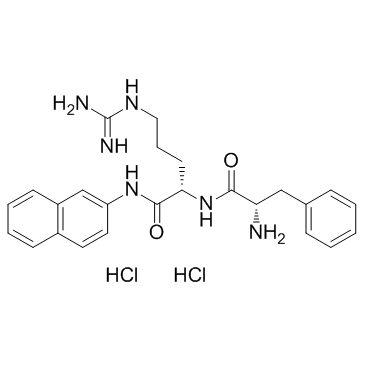PAβN dihydrochloride (MC-207,110 dihydrochloride) |
| رقم الكتالوجGC32063 |
PA&beta ؛ N ثنائي هيدروكلوريد (MC-207.110 ثنائي هيدروكلوريد) (MC-207110 ثنائي هيدروكلوريد) هو مثبط لمضخة التدفق.
Products are for research use only. Not for human use. We do not sell to patients.

Cas No.: 100929-99-5
Sample solution is provided at 25 µL, 10mM.
PAβN dihydrochloride (MC-207110 dihydrochloride) is an efflux pump inhibitor.
PAβN increases the susceptibilities of the three pump-overexpressing mutants of P. aeruginosa to levofloxacin 64-fold. PAβN also potentiates the activity of levofloxacin against strain PAM2391 containing plasmid pAGH97 with the mexXY genes and against wild-type strain PAM1020. PAβN has an effect on susceptibilities to other antibiotics that are substrates of efflux pumps. PAβN increases levels of accumulation of efflux pump substrates inside the cell. It enhances the activity of levofloxacin against clinical isolates of P. aeruginosa[1]. PAβN reduces the MICs in nine ciprofloxacin-resistant isolates, and in four of these, PAβN increases the susceptibility by twofold. Moreover, PAβN restores ciprofloxacin susceptibility in five of the ciprofloxacin-resistant isolates. In addition, clear effects of NMP on the ciprofloxacin MICs are seen for 20 of these ciprofloxacin-resistant isolates[2]. PAβN permeabilizes bacterial membranes in a concentration-dependent manner at levels below those typically used in combination studies, and this additional mode of action should be considered when using PAβN as a control for efflux studies[3].
[1]. Lomovskaya O, et al. Identification and characterization of inhibitors of multidrug resistance efflux pumps in Pseudomonas aeruginosa: novel agents for combination therapy. Antimicrob Agents Chemother. 2001 Jan;45(1):105-16. [2]. Kurin?i? M, et al. Effects of efflux pump inhibitors on erythromycin, ciprofloxacin, and tetracycline resistance in Campylobacter spp. isolates. Microb Drug Resist. 2012 Oct;18(5):492-501. [3]. Lamers RP, et al. The efflux inhibitor phenylalanine-arginine beta-naphthylamide (PAβN) permeabilizes the outer membrane of gram-negative bacteria. PLoS One. 2013;8(3):e60666.
Average Rating: 5 (Based on Reviews and 2 reference(s) in Google Scholar.)
GLPBIO products are for RESEARCH USE ONLY. Please make sure your review or question is research based.
Required fields are marked with *




















